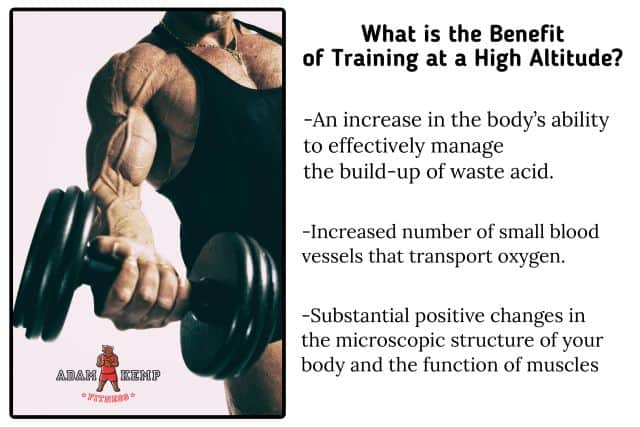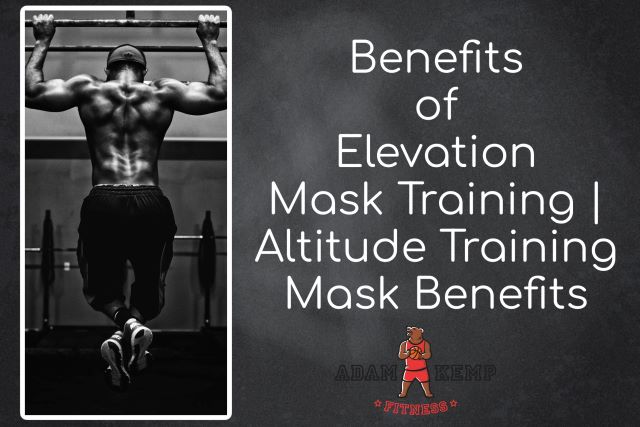Elevation Training Mask Review: Do Altitude Masks Work?
Elevation masks, also known as training masks or altitude masks, have gained popularity among athletes and fitness enthusiasts looking to enhance their workout intensity and respiratory performance.
Although the terms “training mask,” “elevation mask,” and “altitude mask” are often used interchangeably, they each have specific uses and features.
Training masks generally refer to any device that adds resistance to breathing, while elevation and altitude masks are specifically designed to mimic the effects of high-altitude training.
I’ve used both the Elevation Training Mask 2.0 and 3.0 extensively over the years, putting them through rigorous workouts to test their capabilities. In my experience, these altitude masks can indeed help strengthen your lungs and improve your breathing muscles, making your workouts more challenging.
However, they are somewhat cumbersome, which is why I no longer use them regularly.
While elevation training masks are effective at targeting respiratory strength, I believe they are only necessary for elite athletes or those who need to push their endurance to the absolute maximum.
For those looking to increase their cardio-respiratory fitness, these masks offer a range of benefits that make them a worthwhile investment.
However, it’s essential to understand that they don’t truly replicate high-altitude conditions but instead focus on enhancing your body’s ability to work harder by conditioning your breathing muscles.
In this elevation training mask review, we’ll analyze the science behind elevation masks, their benefits, and their value to your training regimen.
If you’re eager to find the best altitude mask available, my top recommendation is the Training Mask 3.0, which you can explore in detail below.
Whether you’re an elite athlete or just someone looking to intensify your workouts, this guide will help you determine if an elevation training mask is the right fit for your fitness goals.
Last update on 2025-07-01 / This article includes affiliate links/Images via Amazon Product Advertising API. I may earn commissions on purchases made through these links.
What is an Altitude Training Mask?
An elevation mask is a training tool designed to mimic the conditions of high-altitude environments.
The primary reason for using an elevation mask is to enhance cardiorespiratory fitness and overall athletic performance.
By restricting oxygen flow, these masks force the body to adapt and utilize oxygen more efficiently, simulating the physiological adaptations that occur at high elevations.
Various training masks have been around for years, but they have become more popular and a mainstream fitness item over the last decade.
What Does an Elevation Training Mask Do?
An elevation training mask restricts the amount of oxygen inhaled during a workout, simulating the low-oxygen conditions of high-altitude environments.
This restriction forces the body to work harder to deliver oxygen to the muscles, improving cardiorespiratory fitness and overall performance.
Do Training Masks Simulate High-Altitude Exercise?
While elevation masks provide a range of benefits, they do not fully mimic genuine high-altitude training.

Altitude simulation training masks were developed based on extensive research into the advantages of actual high-altitude training, which has been acknowledged for its positive effects since the mid-1960s.
True altitude training generally occurs at elevations of 8,000 feet or more, making it inaccessible for many individuals.
The main goal of high-altitude training is to acclimatize the body to hypoxia, a condition marked by diminished oxygen supply.
Under hypoxic conditions, the body faces challenges in generating the required energy for training due to a restricted oxygen supply.
Hypoxia stimulates a series of physiological adaptations that enhance the efficiency of the respiratory, cardiovascular, and oxygen utilization systems.
Notable benefits of high-altitude training include:
- Enhanced ability to manage waste acid build-up in the body
- Increased capillary density for improved oxygen transportation
- Significant improvements in muscle structure and function at a microscopic level
As “Aspects of Haematological Adaptation” outlines, hypoxic exposure increases hemoglobin concentration and hematocrit, training for three weeks at moderate altitudes can raise hemoglobin concentration by 1-4%, and prolonged stays at moderate altitudes can lead to an even more pronounced increase in hemoglobin.
In simpler terms, high-altitude training with reduced oxygen availability stimulates the production of red blood cells and hemoglobin, boosting endurance and overall training capacity.
However, high-altitude training presents certain challenges.
For many individuals, training at high altitudes can be hazardous.
A study in Nordisk Medicin suggests that only top athletes should be selected for training at high altitudes.
Given the difficulty and potential danger associated with high-altitude training, along with geographical limitations, altitude training masks were designed as a more accessible alternative for a wider range of individuals.
These masks offer some of the benefits of high-altitude training without the associated risks or the need to be in a high-altitude location.
Continue reading to discover more about the benefits of elevation training masks.
Benefits of Elevation Mask Training

As I mentioned, altitude-simulation masks have become a trend in the fitness community as the manufacturers of these training masks attempt to replicate the potential benefits of high-elevation training.
With each new version created, elevation masks have become more and more effective at providing a safe and intense workout, yet they still do not truly replicate the effects of high-altitude training.
Here are some of the primary benefits of altitude mask training:
Improved Aerobic Conditioning
Elevation masks force the body to adapt and use oxygen more efficiently, increasing aerobic conditioning and endurance.
Although these masks do not change the actual oxygen content of the air, they can induce hypoxemia through rebreathing expired CO2 that accumulates in the mask’s dead space, as demonstrated by a study at the Human Performance Research Laboratory, Department of Sports & Exercise Sciences at West Texas A&M University.
Enhanced Anaerobic Endurance
With limited oxygen intake, the body relies more on anaerobic energy systems.
Elevation mask training can help improve anaerobic performance, such as sprinting and high-intensity interval training (HIIT).
The Journal of Sports Science and Medicine tested an elevation training mask against common respiratory training methods, concluding that the masks act as respiratory muscle training devices rather than high-altitude simulators.
Increased Lung Capacity
Training with an elevation mask challenges the respiratory muscles, resulting in increased lung capacity and stronger breathing muscles.
Over time, as you increase the resistance of your training mask and the intensity of your workouts, your respiratory system will become stronger and more efficient.
Mental Toughness
The discomfort of restricted breathing during elevation mask training can help athletes develop mental toughness and resilience, pushing through physical and mental barriers.
Convenience
Elevation masks offer similar benefits to high-altitude training without needing to travel to high-altitude locations, making them a practical solution for athletes with limited access to high-elevation training facilities.
Time-savings
Elevation mask workouts can save you time, particularly for cardio workouts.
Many athletes dedicate hours to weekly conditioning drills, but an elevation training mask can help you achieve a more intense workout in less time.
This can also simulate the difficulty of a game or competition more effectively, providing an efficient and convenient training tool.
How to Use an Altitude Training Mask
By incorporating an altitude training mask into your workouts, you can experience a variety of benefits, including improved respiratory muscle strength, increased lung capacity, and enhanced endurance.
Here are some tips for using an elevation training mask to get the best results:
What Type of Workouts to Do with an Altitude Mask
An altitude training mask can be integrated into various types of workouts.
It is best suited for activities that target both aerobic and anaerobic performance, such as running, cycling, high-intensity interval training (HIIT), and strength training.
Incorporating the mask into these workouts can help enhance your respiratory muscle strength, lung capacity, and overall endurance.
Start with Low Resistance
When first using an altitude training mask, begin with the lowest resistance setting.
Most masks have adjustable resistance levels that simulate various elevations.
As your body adapts to the restricted airflow, gradually increase the resistance over time. This progression allows your respiratory system to adjust and prevents the risk of overexertion.
Combine Mask Training with Regular Training
Alternate altitude mask training sessions with regular training sessions to maximize the mask’s benefits.
This approach maintains a well-rounded fitness routine and allows you to target different aspects of your performance.
For instance, you can use the mask during high-intensity interval workouts to improve anaerobic capacity and take it off during lower-intensity sessions to focus on aerobic endurance.
Gradually Increase Workout Intensity
As you become more comfortable with the mask and your respiratory muscles strengthen, challenge yourself by gradually increasing the intensity of your workouts.
Incorporate longer distances, steeper inclines, or more complex exercises to enhance cardiovascular and respiratory fitness.
Track Your Progress
Keep a log of your training sessions, including the mask’s resistance setting, workout duration, and intensity.
This record will help you track your progress and identify areas for improvement.
Regularly assessing your performance will ensure you continue to benefit from altitude mask training and avoid plateaus.
Duration of Altitude Mask Use
When starting with an altitude training mask, it is essential to gradually acclimate your body to the reduced airflow.
Begin by wearing the mask for short periods during your workouts, such as 10 to 15 minutes, and gradually increase the duration as your body adapts.
Eventually, you can work your way up to wearing the mask for the entirety of your workout session.
Monitor Your Body’s Response
Pay attention to how your body reacts to the mask during workouts.
It’s normal to feel a slight increase in difficulty when breathing, but if you experience dizziness, shortness of breath, or any other adverse effects, remove the mask and reduce the resistance.
Listen to your body and adjust your training
to ensure a safe and effective workout.
Frequency of Altitude Mask Training
As with any training regimen, balancing work and recovery is crucial to maximize the benefits and minimize the risk of overtraining.
Aim to incorporate altitude mask training into your routine 2 to 3 times per week, allowing your body to recover and adapt during rest days.
Depending on your fitness level and goals, you can adjust the frequency of mask use accordingly.
How to Wear an Altitude Mask
Ensure the mask is correctly positioned on your face and securely fastened straps for an optimal seal.
The mask should cover your nose and mouth completely, without any gaps or air leaks.
Also, make sure it’s snug but not too tight, as excessive pressure can cause discomfort or skin irritation.
Following the manufacturer’s instructions for proper mask fitting will help you achieve the best results.
Risks and Side Effects of Training Mask Workouts
Elevation training masks offer numerous benefits, but it’s essential to be aware of potential risks and side effects associated with their use.
- Dizziness and lightheadedness: Some individuals may experience dizziness or lightheadedness during mask workouts, particularly when starting out or adjusting to higher resistance levels.
- Shortness of breath: Restricted airflow can lead to shortness of breath, which may be uncomfortable or alarming for some users.
- Pre-existing respiratory conditions: Those with pre-existing respiratory conditions, such as asthma, should consult a healthcare professional before using an elevation training mask to ensure it is safe and appropriate for their needs.
To minimize the risk of side effects:
- Start with the lowest resistance setting and gradually increase it as your body adapts.
- Pay close attention to your body’s response during training sessions and adjust the resistance or stop if necessary.
By being mindful of these potential risks and side effects, you can safely incorporate an elevation training mask into your fitness routine and reap its benefits.
Best Elevation Training Masks: In-Depth Reviews and Recommendations
In this section, we’ll dive into reviews of the best elevation training masks on the market, providing you with the insights you need to make an informed decision.
If you’re ready to take your workouts to the next level, consider investing in a Training Mask 2.0 for a more intense challenge or a Training Mask 3.0 for a smoother, user-friendly experience.
Training Mask 2.0 Review: A Reliable Classic
The Training Mask 2.0 is a popular choice among athletes and fitness enthusiasts.
With interchangeable parts that allow users to adjust the difficulty level, it’s an excellent investment for those looking to enhance their workouts.
The Training Mask 2.0 is particularly well-suited for high-intensity interval training (HIIT) sessions, providing a more intense experience than the newer Training Mask 3.0.
Pros:
- Easily adjustable difficulty levels
- Ideal for HIIT workouts
- Durable and long-lasting
Cons:
- Less smooth airflow than the 3.0 version
Last update on 2025-07-01 / This article includes affiliate links/Images via Amazon Product Advertising API. I may earn commissions on purchases made through these links.
Training Mask 3.0 Review: Smooth and User-Friendly
The Training Mask 3.0, an upgraded version of the 2.0, offers improved airflow and easier resistance adjustments.
Although it’s slightly more expensive, the additional features make it worth the investment.
Pros:
- Smoother airflow for a more comfortable experience
- Easy-to-adjust resistance levels
- Enhanced user-friendly design
Cons:
- Slightly more expensive than the 2.0 version
Last update on 2025-07-01 / This article includes affiliate links/Images via Amazon Product Advertising API. I may earn commissions on purchases made through these links.
Sparthos Training Mask Review: A Solid Alternative
The Sparthos Training Mask is another reliable option for those seeking an elevation training mask.
While it may not be as popular as the Training Mask products, the Sparthos Training Mask still offers a range of benefits and a satisfying training experience.
Pros:
- Good quality and performance
- Suitable for various types of workouts
Cons:
- Not as customizable as the Training Mask products
Rating: 4.4
Last update on 2025-07-01 / This article includes affiliate links/Images via Amazon Product Advertising API. I may earn commissions on purchases made through these links.
This website does not provide medical advice. This website site does contain affiliate links, and purchases may earn a commission.
Read my Medical Disclaimer, Review Disclaimer, and Publishing Policies for more details. Use of this site indicates acceptance of these terms.






